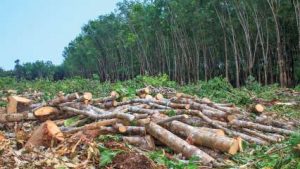India State Of Forest Report-2021:

The Union Ministry of Environment, Forests and Climate Change (MoEFCC) released the India State of Forest Report-2021.
- In October, 2021 an amendment was proposed by MoEFCC to the Forest (Conservation) Act, 1980 to bring significant changes to forest governance in India.
- It is an assessment of India’s forest and tree cover, published every two years by the Forest Survey of India.
- The first survey was published in 1987, and ISFR 2021 is the 17th.
- India is one of the few countries in the world that brings out such a survey every two years, and this is widely considered comprehensive and robust.
- The ISFR is used in planning and formulation of policies in forest management as well as forestry and agroforestry sectors.
- Three categories of forests are surveyed – very dense forests (canopy density over 70%), moderately dense forests (40-70%) and open forests (10-40%).
- Scrubs (canopy density less than 10%) are also surveyed but not categorised as forests.
New Features of ISFR 2021:
- It has for the first time assessed forest cover in tiger reserves, tiger corridors and the Gir forest which houses the Asiatic lion.
- The forest cover in tiger corridors has increased by 37.15 sq km (0.32%) between 2011-2021, but decreased by 22.6 sq km (0.04%) in tiger reserves.
- Forest cover has increased in 20 tiger reserves in these 10 years, and decreased in 32.
- Buxa (West Bengal), Anamalai (Tamil Nadu) and Indravati reserves (Chhattisgarh) have shown an increase in forest cover while the highest losses have been found in Kawal (Telangana), Bhadra (Karnataka) and the Sunderbans reserves (West Bengal).
- Pakke Tiger Reserve in Arunachal Pradesh has the highest forest cover, at nearly 97%.
Findings of the Report:
- The forest and tree cover in the country continues to increase with an additional cover of 1,540 square kilometres over the past two years.
- India’s forest cover is now 7,13,789 square kilometres, 21.71% of the country’s geographical area, an increase from 21.67% in 2019.
- Tree cover has increased by 721 sq km.
- Tree cover is defined as all tree patches of size less than one hectare occurring outside the recorded forest area. This covers trees in all formations including scattered trees.
Increase/Decrease in Forests:
- The states that have shown the highest increase in forest cover are Telangana (3.07%), Andhra Pradesh (2.22%) and Odisha (1.04%).
- Five states in the Northeast – Arunachal Pradesh, Manipur, Meghalaya, Mizoram and Nagaland have all shown loss in forest cover.
States with Highest Forest Area/Cover:
- Area-wise: Madhya Pradesh has the largest forest cover in the country followed by Arunachal Pradesh, Chhattisgarh, Odisha and Maharashtra.
- In terms of forest cover as percentage of total geographical area, the top five States are Mizoram, Arunachal Pradesh, Meghalaya, Manipur and Nagaland.
- The term ‘forest area’ denotes the legal status of the land as per the government records, whereas the term ‘forest cover’ indicates presence of trees over any land.
Mangroves:
- Mangroves have shown an increase of 17 sq km. India’s total mangrove cover is now 4,992 sq km.
Forest Prone to Fires:
- 35.46% of the forest cover is prone to forest fires. Out of this, 2.81% is extremely prone, 7.85% is very highly prone and 11.51% is highly prone.
- By 2030, 45-64% of forests in India will experience the effects of climate change and rising temperatures.
- Forests in all states (except Assam, Meghalaya, Tripura and Nagaland) will be highly vulnerable climate hot spots. Ladakh (forest cover 0.1-0.2%) is likely to be the most affected.
Total Carbon Stock:
- The total carbon stock in the country’s forests is estimated at 7,204 million tonnes, an increase of 79.4 million tonnes since 2019.
- Forest carbon stock is the amount of carbon that has been sequestered from the atmosphere and is now stored within the forest ecosystem, mainly within living biomass and soil, and to a lesser extent also in dead wood and litter.
- Bamboo forests have grown from 13,882 million culms (stems) in 2019 to 53,336 million culms in 2021.




